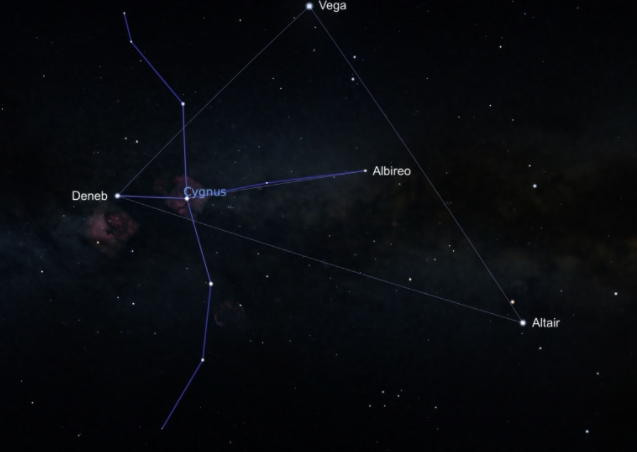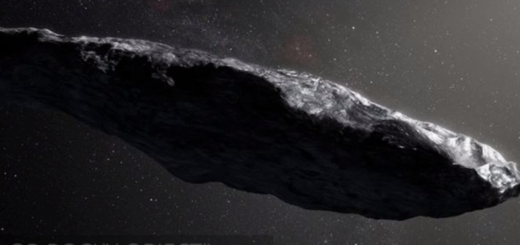Exquisite Albireo, A Much-Loved Double Star

View larger. The constellation Cygnus lies within a larger star pattern known as the Summer Triangle. See the three bright stars here: Vega, Deneb and Altair? See how the pattern of the cross (Cygnus the Swan) lies inside the triangle made by those three stars? Once you’ve located it, you’ll find Albireo at the end of the cross. Image via Stellarium app.
Albireo is 2 stars
Albireo, also known as Beta Cygni, is the second-brightest star in the constellation Cygnus the Swan. At first glance, it doesn’t particularly stand out. But viewing this star through a small telescope can take your breath away. It resolves into a striking double, with one component a lovely gold star and the other a dimmer blue close by. Although the two stars appear close in the sky, from our perspective, astronomers still don’t know for sure if they’re gravitationally bound to each other. It doesn’t matter. The color contrast between the two is so striking and so beautiful that Albireo is one of the sky’s most beloved stars.
How can you spot Albireo in the night sky? It’s easy to find, if you can locate Cygnus the Swan. Cygnus has an easy-to-recognize shape, that of a cross, and the constellation is also known as the Northern Cross. The brightest star in Cygnus, called Deneb, marks the head of the Cross or the Tail of the Swan. Albireo marks the base of the Cross or the Head of Cygnus.
And how can you see Albireo as two stars? They’re best viewed at 30X (“30 power” or a magnification of 30). Unless you have exceedingly powerful binoculars, mounted on a tripod, binoculars won’t show you Albireo as two stars. But any small telescope will. When you do see Albireo as two stars, be sure to notice the striking color contrast between the two.
Double star Albireo in star field. One star is orange-yellow and the other one a dimmer blue.
An image of Albireo taken with a camera attached to a 12-inch telescope. Image via Tom Wildoner / Flickr.
Star chart of Cygnus with stars in black on white and green lines showing labeled constellations.
A star map of Cygnus. Image via International Astronomical Union/ Sky & Telescope/ Wikimedia Commons.
Science of Albireo
The brighter gold star, known as Albireo A, is about 430 light-years away. Albireo B, the dimmer blue star, is around 400 light-years distant. It’s not yet clear if these two stars are distantly-spaced binary stars. An analysis of their motion in space, from ground- and space-based telescopes suggests they aren’t gravitationally bound to each other. But astronomers say they need more measurements to come to a definite conclusion.
So is it just by chance that “A” and “B” appear close to each other in our night sky? According to a paper published in January 2021, there’s evidence from spectroscopic data that they formed around the same time. Astronomers also found a few other stars in close proximity to them with similar motions in space. They suspect these stars and the Albireo system are what’s left of an open star cluster (a family of stars) formed together about 100 million years ago.
Albireo A’s binary star system has an orbital period of 121.6 years. The brighter star is responsible for the gold color you see through a telescope; it’s a red supergiant star, about 5 times the mass of the sun. It outshines its fainter companion, a hot main sequence star that’s 2.7 times the sun’s mass. However, in a recent analysis of the Albireo A binary system, astronomers were surprised to find that there may be another yet undetected star in the mix, possibly making Albireo A a triple star system.
Albireo B, the fainter blue star of the pair when viewed through a small telescope, appears just 34 arc seconds away from gold-colored Albireo A. It’s a hot blue star, about 3.7 times the sun’s mass.
Antique etching of several constellations with colored pictures and stars in black.
The constellations Lacerta, Cygnus and Lyra, with Vulpecula and Anser (depicted in modern star charts as just “Vulpecula”) from Urania’s Mirror, a set of celestial cards by Sidney Hall published in 1825. Image via Wikimedia Commons.
Bottom line: Through a telescope, Albireo, a seemingly nondescript star in the constellation Cygnus, pops as a stunning gold and blue double star. Astronomers still don’t know if Albireo is a binary star but think its stars were formed around the same time.



 Creators of mankind
Creators of mankind Description of “Tall white aliens”
Description of “Tall white aliens” Where they came from?
Where they came from? About hostile civilizations
About hostile civilizations The war for the Earth
The war for the Earth “Tall white aliens” about eternal life
“Tall white aliens” about eternal life Video: “Nordic aliens”
Video: “Nordic aliens” Aliens
Aliens Alien encounters
Alien encounters The aliens base
The aliens base UFO
UFO Technology UFO
Technology UFO Underground civilization
Underground civilization Ancient alien artifacts
Ancient alien artifacts Military and UFO
Military and UFO Mysteries and hypotheses
Mysteries and hypotheses Scientific facts
Scientific facts


















